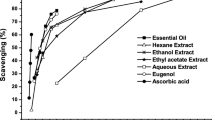Abstract
The aim of this study was to evaluate the antioxidant properties of an edible lichen Ramalina conduplicans. The extract exhibited potent anti-linoleic acid peroxidation activity, free radical-scavenging activity, and reducing power. The total phenolic contents were found to be high in the extract. Activity-guided bioautographic thin layer chromatography (TLC) and HPLC identified sekikaic acid and homosekikaic acid as the main free radical-scavenging compounds in R. conduplicans extract (IC50 [50% inhibition concentration] = 0.082 and 0.276 mg/ml, respectively). The results suggested that this edible lichen species have the potential to be utilized as food additives or as protective drugs.




Similar content being viewed by others
References
Behera BC, Verma N, Sonone A, Makhija U (2006) Determination of antioxidative potential of lichen Usnea ghattensis in vitro. LWT Food Sci Technol 39:80–85
Blois MS (1958) Antioxidant determinations by the use of a stable free radical. Nature 26:1199–1200
Bowler PA, Rundel PW (1974) The Ramalina intermedia complex in North America. Bryologist 77:617–623
Chaaib F, Queiroz EF, Ndjoko K, Diallo D, Hostettmann K (2003) Antifungal and antioxidant compounds from the root bark of Fagara zanthoxyloides. Planta Med 69:316–320
Choudhary MI, Ali S, Thadani VM, Karunaratne V (2009) Patent No. US 20090048332. http://www.faqs.org/patents/app/20090048332
Dias DA, Urban S (2009) Phytochemical investigation of the Australian lichens Ramalina glaucescens and Xanthoria parietina. Nat Prod Commun 4:959–964
Grice HC (1986) Safety evaluation of butylated hydroxytoluene (BHT) in the liver, lung and gastrointestinal tract. Food Chem Toxicol 24:1127–1130
Gülçin İ, Oktay M, Küfrevioğlu Öİ, Aslan A (2002) Determination of antioxidant activity of lichen Cetraria islandica (L.) Ach. J Ethnopharmacol 79:325–329
Gulluce M, Aslan A, Sokmen M, Sahin F, Adiguzel A, Agar G, Sokmen A (2006) Screening the antioxidant and antimicrobial properties of the lichens Parmelia saxatilis, Platismatia glauca, Ramalina pollinaria, Ramalina polymorpha and Umbilicaria nylanderiana. Phytomedicine 13:515–521
Hanus LO, Temina M, Dembitsky V (2008) Biodiversity of the chemical constituents in epiphytic lichenized ascomycete Ramalina lacera grown on difference substrates Crataegus sinaicus, Pinus halepensis, and Quercus calliprions. Biomed Pap 152:203–208
Liu XY, Fu H (2003) Determination of trace element of 4 lichens in Yunnan. Stud Trans Elem Health 20:30–31
Lo KM, Cheung PCK (2005) Antioxidant activities of extracts from the fruiting bodies of Agrocybe aegerita var. alba. Food Chem 89:533–539
Luo H, Yamamota Y, Kim JA, Jung JS, Koh YJ, Hur JS (2009) Lecanoric acid, a secondary lichen substance with antioxidant properties from Umbilicaria antarctica in maritime Antarctica (King George Island). Polar Biol 32:1033–1040
Mitsuda H, Yuasumoto K, Iwami K (1996) Antioxidation action of indole compounds during the autoixdation of linoleic acid. Nihon Eiyo Shokuryo Gakkai Shi 19:210–214
Odabasoglu F, Asland A, Cakir A, Suleyman H, Karagoz Y, Bayir Y, Halici M (2005) Antioxidant activity, reducing power and total phenolic contents of some lichen species. Fitoterapia 76:216–219
Oksanen I (2006) Ecological and biotechnological aspects of lichens. Appl Microbiol Biotechnol 73:723–734
Oyaizu M (1986) Studies on product of browning reaction prepared from glucose amine. Jpn J Nutr 44:307–315
Rice-Evans CA, Miller NJ, Bolwell PG, Barmley PM, Pridham JB (1995) The relative antioxidant activities of plant derived polyphenolic flavonoids. Free Radic Res 22:375–383
Scandalios JG (1997) Oxidative stress and the molecular biology of antioxidant defenses. Cold Spring Harbor Laboratory Press, New York
Slinkard K, Singleton VL (1977) Total phenol analysis: automation and comparison with manual methods. Am J Enol Vitic 28:49–55
Stocker-Wörgötter E (2008) Metabolic diversity of lichen-forming ascomycetous fungi: culturing, polyketide and shikimate metabolite production, and PKS gene. Nat Prod Rep 25:188–200
Tsai SY, Huang SJ, Lo SH, Wu TP, Lian PY, Mau JL (2009) Flavour components and antioxidant properties of several cultivated mushrooms. Food Chem 113:578–584
Upreti DK, Divakar PK, Nayaka S (2005) Commercial and ethnic use of lichens in India. Econ Bot 59:269–273
Wang LS, Narui T, Harada H, Culberson CF, Culberson WL (2001) Ethnic uses of lichens in Yunnan, China. Bryologist 104:345–349
Wichi HP (1988) Enhanced tumor development by butylated hydroxyanisole (BHA) from the prospective of effect on forestomach and oesophageal squamous epithelium. Food Chem Toxicol 26:717–723
Yamamoto Y, Mizuguchi R, Yamada Y (1985) Tissue cultures of Usnea rubescens and Ramalina yasudae and production of usnic acid in their cultures. Agric Biol Chem 49:3347–3348
Yu BP, Yang R (1996) Critical evaluation of the free radical theory of aging, a proposal for the oxidative stress hypothesis. Ann N Y Acad Sci 786:1–11
Acknowledgments
This work was supported by a grant from the Korea National Research Resource Center Program (Grant 20090062634) and also by a Korea Research Foundation Grant funded by the Korean Government (MOEHRD, Basic Research Promotion Fund) (KRF-2007-313-C00669).
Author information
Authors and Affiliations
Corresponding author
About this article
Cite this article
Luo, H., Wei, X., Yamamoto, Y. et al. Antioxidant activities of edible lichen Ramalina conduplicans and its free radical-scavenging constituents. Mycoscience 51, 391–395 (2010). https://doi.org/10.1007/s10267-010-0048-5
Received:
Accepted:
Published:
Issue Date:
DOI: https://doi.org/10.1007/s10267-010-0048-5




